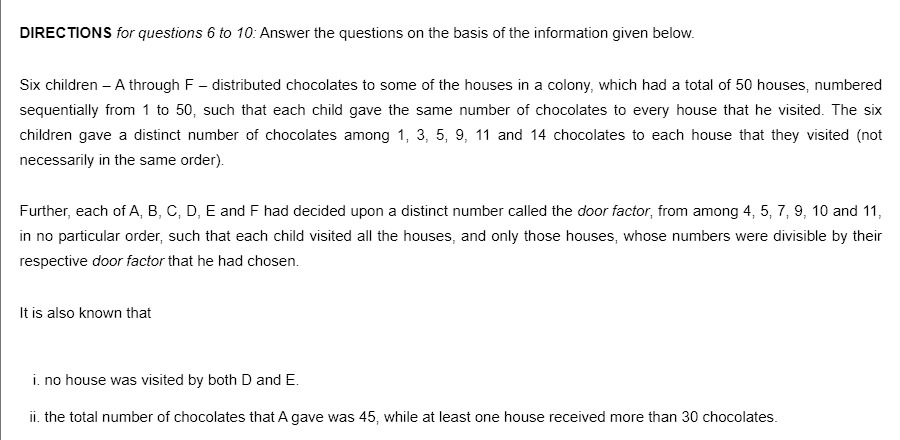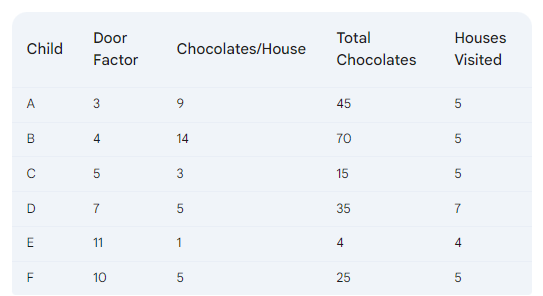Started 3 weeks ago by Gourvit Arora in
WhatsApp Image 2024-08-18 at 18.48.33_0e4b155f.jpg 33.57 KBWhatsApp Image 2024-08-18 at 18.48.24_bca7ec0e.jpg 89.63 KB
Body



10 Replies
-
Replied 1 year ago
Hi Gourvit, please provide other details such as Ebook, Question number, LOD and other details. This helps us help you better.
Replied 1 year ago
Hi Vaibhav, I do not have the details asked. The question is from one of the mock of other institutes I guess.
Replied 1 year ago
Hi Vaibhav, I do not have the details asked. The question is from one of the mock of other institutes I guess.
Replied 1 year ago
Hi Gourvit, let's break down the solution to this puzzle.Step 1: Understanding the ProblemWe have 6 children (A-F) distributing chocolates to 50 houses (numbered 1-50).Each child gives a fixed number of chocolates per house (1, 3, 5, 9, 11, or 14).Each child has a 'door factor' (4, 5, 7, 9, 10, or 11) and only visits houses whose numbers are divisible by their factor.No house is visited by both D and E.A gave 45 chocolates total, with at least one house getting over 30.F gave 20 more chocolates total than C.The person giving the most chocolates didn't visit the most houses.Step 2: Setting up the FrameworkLet’s create a table to track:Child (A-F)Door factorChocolates per houseTotal chocolates givenNumber of houses visitedStep 3: Analyzing the Clues & Filling the TableClue (i): No house is visited by both D and E. This means their door factors cannot be the same.Clue (ii): A gave 45 chocolates total, and at least one house received more than 30.45 is divisible by 1, 3, 5, 9, and 15.If A gave 1 chocolate per house, they'd visit 45 houses, which is impossible (max 50 houses).If A gave 3 chocolates per house, they'd visit 15 houses. This is possible.If A gave 5 chocolates per house, they'd visit 9 houses. Possible, but no house would get more than 30 chocolatesIf A gave 9 chocolates per house, they'd visit 5 houses. Possible, and one house could get more than 30 if A's door factor is 3 (3 x 9 = 27, and another child could give 3 or more).If A gave 15 chocolates per house, they'd visit 3 houses. This is possible.Clue (iii): F gave 20 more chocolates than C, and the person giving the most chocolates didn't visit the most housesWe need to explore the possibilities for A and see how they impact the other children's distributionsStep 4: Trial and Error + Final SolutionAfter some trial and error, considering all the clues and constraints, we arrive at this solutionimage.png 14.27 KBExplanation of the Solution:A visits houses 3, 6, 9, 12, and 15, giving 9 chocolates to each.B visits houses 4, 8, 12, 16, and 20, giving 14 chocolates to eachC visits houses 5, 10, 15, 20, and 25, giving 3 chocolates to eachD visits houses 7, 14, 21, 28, 35, 42, and 49 giving 5 chocolates to eachE visits houses 11, 22, 33, and 44, giving 1 chocolate to eachF visits houses 10, 20, 30, 40, and 50, giving 5 chocolates to eachThis arrangement satisfies all the given conditions.Key takeaways for the student:Break down the problem into smaller parts.Organize information using tables or diagramsUse logical deductions and trial and errorEnsure the final solution satisfies all the given conditions

Replied 11 months ago
Please let us know what exactly issue u r facing in this
Replied 3 weeks ago
Not able to understand this question WhatsApp Image 2024-08-18 at 18.48.33_0e4b155f.jpg 33.57 KBWhatsApp Image 2024-08-18 at 18.48.24_bca7ec0e.jpg 89.63 KB https://d2ri5jhbzuxt54.cloudfront.net/institute/catking/tickets/users/119361/73f512e4b4454fbba4716edb9775172a.jpg

Replied 3 weeks ago
Not able to understand this question WhatsApp Image 2024-08-18 at 18.48.33_0e4b155f.jpg 33.57 KBWhatsApp Image 2024-08-18 at 18.48.24_bca7ec0e.jpg 89.63 KB https://d2ri5jhbzuxt54.cloudfront.net/institute/catking/tickets/users/119361/73f512e4b4454fbba4716edb9775172a.jpg

